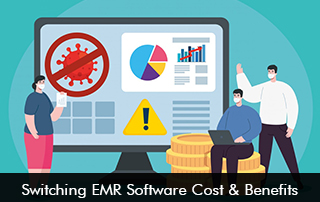EMR software is the backbone of modern healthcare practices. It streamlines patient data management, improves clinical workflows, and enhances patient care. However, as technology evolves, many healthcare providers find themselves needing to switch EMR software to keep up with advancements, compliance requirements, or better usability.
But switching Electronic Medical Records software is a major decision. It involves costs, training, and potential disruptions. In this blog, we’ll break down the costs and benefits of transitioning to a new EMR system and help you determine if it’s the right move for your practice.
Why Consider Switching EMR Software?
Before diving into costs, it’s important to understand why many practices choose to switch EMR software in the first place.
1. Outdated Technology
Older EMR systems may lack modern features like cloud-based access, telehealth integration, or AI-driven analytics. If your current system feels sluggish or lacks essential tools, an upgrade could significantly improve efficiency.
2. Poor User Experience
If your staff struggles with a clunky interface or excessive clicks to complete simple tasks, productivity suffers. A more intuitive EMR software can reduce frustration and save time.
3. Lack of EMR Software Interoperability
Modern healthcare relies on seamless data exchange between providers, labs, and pharmacies. If your EMR doesn’t integrate well with other systems, switching may be necessary for better care coordination.
4. High Maintenance Costs
Legacy EMR systems often require expensive server maintenance, updates, and IT support. Moving to a cloud-based EMR can cut these costs significantly.
5. Compliance & Security Risks
Healthcare regulations (like HIPAA) constantly evolve. If your current EMR isn’t keeping up with security standards, a switch may be unavoidable to avoid fines or data breaches.
The Costs of Switching EMR Software
Switching EMR software isn’t free—it requires financial investment, time, and effort. Below are the key cost factors to consider.
1. Upfront EMR Software Costs
-
Licensing Fees: Some EMR vendors charge per provider or user.
-
Subscription vs. One-Time Purchase: Cloud-based EMRs often use monthly subscriptions, while on-premise systems may require a large upfront payment.
-
Customization Costs: Tailoring the EMR to your practice’s needs may add extra expenses.
2. Data Migration Expenses
Transferring patient records from your old EMR to the new one isn’t always seamless. You may need:
-
Data Extraction Tools to pull records from the legacy system.
-
Cleaning & Formatting to ensure data integrity.
-
Third-Party Services if your new EMR vendor doesn’t handle migration.
3. Training & Onboarding
Your staff will need time to learn the new system, which means:
-
Paid Training Sessions (in-person or online).
-
Temporary Productivity Loss as employees adjust.
-
Ongoing Support Costs for troubleshooting.
4. Hardware & Infrastructure Upgrades
If switching to a more advanced EMR, you might need:
-
New Computers or Tablets if the software has higher system requirements.
-
Stronger Internet Bandwidth for cloud-based EMRs.
-
Server Upgrades (if sticking with an on-premise solution).
5. Downtime & Lost Revenue
During the transition, your practice may experience:
-
Slower Workflows as staff adapt.
-
Fewer Patient Appointments if scheduling is disrupted.
-
Potential Errors that could lead to billing delays.
The Benefits of Switching EMR Software
Despite the costs, switching EMR software can bring long-term advantages that outweigh initial challenges.
1. Improved EMR Software Efficiency & Productivity
-
Faster Charting: Modern EMRs reduce clicks with templates and voice recognition.
-
Automated Workflows: Tasks like billing, e-prescribing, and lab orders become quicker.
-
Mobile Access: Providers can update records on the go via smartphones or tablets.
2. Better Patient Care
-
Integrated Telehealth: Many new EMRs include virtual visit capabilities.
-
Clinical Decision Support: AI-powered alerts help reduce errors.
-
Patient Portals: Secure messaging and online scheduling improve engagement.
3. Cost Savings Over Time
-
Lower IT Costs: Cloud-based EMRs eliminate server maintenance fees.
-
Reduced Paper Use: Less printing, scanning, and physical storage needed.
-
Fewer Errors: Automated coding and billing reduce claim denials.
4. Enhanced EMR Software Security & Compliance
-
HIPAA-Compliant Features: Encryption, audit logs, and multi-factor authentication.
-
Regular Updates: Cloud EMRs automatically patch security vulnerabilities.
5. Scalability for Growth
-
Add Providers Easily: No need for complex installations.
-
Support for Multiple Locations: Cloud EMRs centralize data across clinics.
How to Minimize Costs When Switching EMR Software
If you decide to switch EMR software, follow these tips to reduce expenses and disruptions.
1. Choose the Right EMR Vendor
-
Compare Pricing Models (subscription vs. perpetual license).
-
Look for Free Training & Support to cut onboarding costs.
-
Check for Hidden Fees (e.g., extra charges for API integrations).
2. Plan Data Migration Carefully
-
Clean Data Before Transfer to avoid errors.
-
Run a Pilot Test with a small batch of records first.
-
Keep Old Records Accessible during transition (read-only mode).
3. Train Staff Effectively
-
Phased Training (start with super-users who can train others).
-
Use Vendor Resources (webinars, tutorials, and FAQs).
-
Schedule Training During Downtime to minimize workflow impact.
4. Negotiate with Vendors
-
Ask for Discounts (especially for multi-year contracts).
-
Request Extended Support at no extra cost.
-
Inquire About Bundled Services (e.g., free data migration).
Final Thoughts: Is Switching EMR Software Worth It?
The decision to switch EMR software depends on your practice’s unique needs. While the upfront costs and transition period can be daunting, the long-term benefits (better efficiency, improved patient care, and lower operational costs) often justify the move.
Before making the switch:
✔ Evaluate your current EMR’s shortcomings.
✔ Compare multiple EMR vendors.
✔ Calculate ROI based on cost savings and productivity gains.
If your current EMR is holding your practice back, upgrading could be one of the best investments you make.







